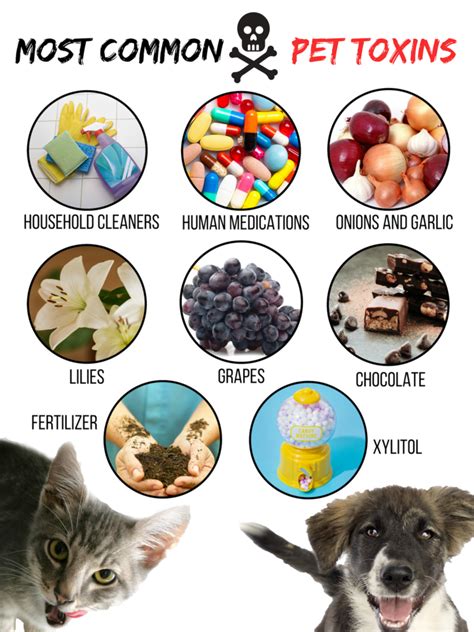Introduction
Our beloved pets, whether furry companions or feathered friends, are cherished members of our families. However, their curious nature can inadvertently expose them to potentially harmful substances. Pet poison control and understanding the dangers of various toxins are crucial for ensuring our furry friends’ health and well-being. This article delves into the essential aspects of pet poison control, arming you with knowledge to safeguard your pets from harm.

Common Pet Toxins to Watch For
According to the American Society for the Prevention of Cruelty to Animals (ASPCA), over 164,000 calls were made to their Animal Poison Control Center in 2020. Ingestion of toxic substances accounted for over 70% of these cases. Some of the most prevalent pet toxins include:
- Insecticides and Pesticides: These can cause a wide range of symptoms, including tremors, vomiting, seizures, and respiratory distress.
- Human Medications: Many common over-the-counter and prescription medications can be fatal to pets, such as ibuprofen, acetaminophen, and antidepressants.
- Household Cleaners: Bleach, detergents, and ammonia can irritate the skin, eyes, and respiratory system of pets.
- Plants: Certain plants, such as lilies, daffodils, and oleander, contain toxic compounds that can cause severe illness or even death.
- Foodstuffs: Chocolate, grapes, and onions are toxic to dogs, while avocados and macadamia nuts can be dangerous for cats.
Recognizing Signs of Poisoning
Promptly recognizing signs of poisoning is crucial for effective treatment. If you suspect your pet has ingested a toxic substance, watch for the following signs:
- Vomiting
- Diarrhea
- Tremors
- Seizures
- Difficulty breathing
- Lethargy
- Drooling
- Pawing at the mouth
- Dilated pupils
Pet Poison Control: What to Do in an Emergency
- Stay Calm: Panicking will only make the situation worse.
- Call your Veterinarian or Poison Control Center: Contact your veterinarian immediately or call a poison control hotline, such as the ASPCA Animal Poison Control Center at (888) 426-4435.
- Identify the Toxin: If possible, bring the substance or packaging your pet may have ingested to the veterinarian.
- Provide Information: Be prepared to provide your pet’s species, age, weight, and any other relevant information.
- Monitor Your Pet: If possible, keep your pet calm and monitor their breathing and other vital signs until veterinary assistance arrives.
Preventing Pet Poisonings: Strategies for a Safe Home
- Secure Toxins: Keep all potentially poisonous substances out of reach of your pets. Lock cabinets and drawers containing medications, household cleaners, and pesticides.
- Inspect Your Yard: Remove or fence off plants that are toxic to pets.
- Educate Family Members: Make sure everyone in the household knows about pet poisoning risks and how to avoid them.
- Supervise Pets: Keep an eye on your pets when they are outside or in areas where they could encounter potential toxins.
- Consider Pet Insurance: Pet insurance can provide coverage for veterinary expenses in case of poisoning.
FAQs on Pet Poison Control
-
What should I do if I suspect my pet has been poisoned but cannot identify the toxin?
Contact a veterinarian or poison control center immediately and provide as much information as possible about your pet’s symptoms and actions.
-
Can I induce vomiting in my pet?
Inducing vomiting is not always recommended and can be dangerous. Contact a veterinarian or poison control center for specific instructions on whether this is appropriate.
-
How can I prevent my pet from getting into toxins?
The best prevention is to secure all potentially poisonous substances and educate family members and visitors about pet poisoning risks.
-
What is the prognosis for pets who have been poisoned?
The prognosis for pets who have been poisoned depends on the type of toxin, the amount ingested, and how quickly treatment is initiated.
-
Are there any new trends in pet poison control?
Telemedicine and online poison control services are becoming increasingly available, providing convenient and accessible options for pet owners in need of assistance.
-
How can I improve my knowledge of pet poison control and keep up with the latest research?
Consult with your veterinarian, attend pet safety workshops, and subscribe to reputable sources of information on pet health and toxicology.
Conclusion
Pet poison control is an essential aspect of responsible pet ownership. By understanding the common pet toxins, recognizing signs of poisoning, and implementing preventive measures, you can significantly reduce the risk of your furry companion ingesting harmful substances. Remember, prompt action in case of an emergency can greatly improve the chances of a positive outcome. Embrace this knowledge and take proactive steps to ensure your pet’s health and well-being for years to come.





















